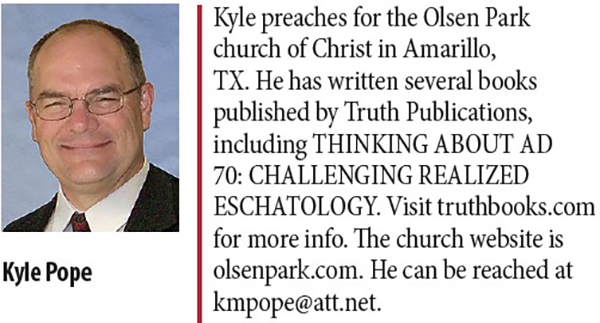by Kyle Pope
Synopsis: A final point used to support the “transition verse” view of Matthew 24:34 is the use of “immediately” in 24:29. Does such language demand connecting the coming of Jesus in 24:29-33 with AD 70?
In our previous article, we considered that, throughout the New Testament, language similar to Matthew 24:29-33 is applied literally to Jesus’s Second Coming. We also noted that 24:33 qualifies the things included within the phrase “all these things” to events they would actually “see.” These facts challenge the conclusion that all things before 24:34 only address the destruction of Jerusalem in AD 70. The apocalyptic language of 24:29-33 cannot be figurative, spiritual, and unseen, yet at the same time be among things Jesus said they would “see.” This article will explore a final point that leads many to accept the “transition verse” view of Matthew 24:34.
Matthew 24:29 begins, “Immediately (eutheōs) after the tribulation of those days” (NKJV), and then describes apocalyptic events associated with the coming of the Son of Man (24:29b-33). The argument is that the Greek word eutheōs, translated “immediately,” demands little or no time interval between the “tribulation of those days” (i.e., AD 70) and the coming of Jesus in the following verses. For the “transition verse” view to be correct, it must be proven that the force of eutheōs is so conclusive that there is no question it connects the “Abomination of Desolation” (24:15) and the time of “great tribulation” (24:21) with the “Son of Man coming on the clouds” (24:30). On the other hand, if eutheōs is a relative term that can apply to different time intervals, it does not demand that we interpret 24:29-33 figuratively.
There is no question that this word often applies to small time intervals. The question is whether its intrinsic meaning carries sufficient force to nullify a literal interpretation of 24:29-33 by other NT writers, and to include these unseen events within “all these things” Jesus said would be seen (24:33-34). A flaw in this reasoning assumes that the conceptual basis of eutheōs is smallness. That leads to the assumption that, when applied to time, the issue is the span of time. That is incorrect. In fact, its conceptual basis is straightness, so when applied to time, the period can vary, but the directness in relation to sequence or importance is the emphasis. Treating this as a precise measurement of something small is a misunderstanding of its full scope.
This is seen from the foremost Lexicon of the ancient Greek language, A Greek-English Lexicon, by Henry George Liddell and Robert Scott, revised by Sir Henry Stuart Jones (Oxford: Clarendon Press, 1940)—usually abbreviated LSJ. This lexicon does not promote a religious perspective but focuses on word meaning in Classical, Hellenistic, and Koine Greek (ca. 700 BC-AD 500). The entry for this word is available online.
A survey of its entry in LSJ shows that eutheōs is an adverbial form of euthus, and both words are used interchangeably with the same meaning. The first and primary definition of euthus, with documented sources, reads (A) “straight, direct, whether vertically or horizontally, as opposed to skolios [curved], kampulos [bent].” It was used of the vertical of a spinning top, of a straight road (as in Acts 9:11, “Straight Street” and Matt. 3:3, Mark 1:3, and Luke 3:4-5 of “straight paths”). It referred to going straight forward, in a direct line, or on the same side. The second portion, explaining its use in a moral sense, reads (2) “straightforward, frank, to speak straight out, outright, openly, without reserve, by direct reasoning.” From this, we see that its moral sense is derived from its primary conceptual basis of straightness. Let’s note that in a metaphorical sense, euthus can mean “at once, naturally.” It can be used of manner: (3) “directly, simply” and (4) in the sense of “for instance, to take the first example that occurs.” This demonstrates that while the conceptual basis of this word is the straightness of something, at times, it serves a narrative function, simply pointing to the next thing in the story with little or no connection to the time involved.
The final sections in LSJ (C) deal specifically with the adverb eutheōs. It explains that it is “used just as euthus.” That tells us that all that is said about euthus applies equally to this form of the word. It cites examples such as “as soon as he perceived” and “since he breathed out immediately.” The final subsection (2) repeats that eutheōs “= euthus,” showing an example of it with the word oion [such as] to mean “as for example.” It also explains that “eutheōs is the commoner form in later Greek,” which is significant for our discussion of Biblical Greek.
The use of eutheōs and euthus in the Septuagint (LXX) and the Greek NT attest that many (if not all) of the applications cited from LSJ are attested in Biblical Greek. Often euthus is used of the “straight road” or path. “The voice of one crying in the wilderness: ‘Prepare the way of the LORD; make straight (euthus) in the desert a highway for our God. Every valley shall be exalted and every mountain and hill brought low; The crooked places shall be made straight (euthus) and the rough places smooth’” (Isa. 40:3-4; cf. 42:16; Matt. 3:3; Mark 1:3; Luke 3:4-5; Acts 13:10; et al.). This frequent usage demonstrates that, however we understand the application of this to time, the conceptual basis refers to the straightness of something.
When applied to time, how are these words used in the New Testament? Examples of eutheōs and euthus clearly show they are relative terms that can apply to different time intervals.
The Parable of the Sower. In the Parable of the Sower, it is used of the seed sown on stony places that “immediately (eutheōs) sprang up” (Matt. 13:5). Obviously, some time was involved between sowing and springing up.
“See You Shortly.” In 3 John 14, John uses eutheōs (translated “shortly”) of his desire to come to the brethren and see them “face to face.” This does not set a specific measure of time (such as “in two years”) but a relative time interval. The context limits the time interval intended because John and the brethren to whom he wrote had limited lifespans. What if John and the brethren had lived for centuries (as the patriarchs did)? Would that extend the interval of the term “shortly (eutheōs)” by centuries? Yes. What if one of the parties in such a statement was God (with an unlimited lifespan)? Would that extend the interval allowed by the term “shortly (eutheōs)” even further? Yes. That’s precisely the case in Matthew 24-25. Jesus (one eternal in nature) describes times and seasons to mortal man.
The Parable of the Talents. In Matthew 25:15-16, in the Parable of the Talents, eutheōs comes at either the end of 24:15 or the beginning of 24:16. This is why the editors of the KJV (and NKJV) have the master leaving “immediately,” while the NASB (and others) say of the five talent man, “immediately the one who had received the five talents went and traded with them, and gained five more talents.” Would there be various intervals in how long it would take the master to leave, or the servant to go (or if “immediately” extends to trading and gaining “five more talents”)? Yes. Clearly, eutheōs is a relative term, not a set measurement of time.
“Long Time.” Some have argued that since eutheōs is not applied to the master’s return in the Parable of the Talents, we cannot understand its use in Matthew 24:29 to allow for a “long time” between the time of “great tribulation” and the “Son of Man coming on the clouds.” However, let’s think about this. The Parable of the Talents (Matt. 25:14-30) comes within the same discourse as Matthew 24:29-33. The majority of Greek manuscripts, just before their beginning, read, “Watch therefore, for you know neither the day nor the hour in which the Son of Man is coming” (25:13, NKJV), and then continue, “For it is just like a man about to go on a journey” (25:14a, NASB). That shows us the coming of the Son of Man is “just like” a man who goes on a journey. Right after this parable, Jesus continues, “When the Son of Man comes in His glory, and all the holy angels with Him, then He will sit on the throne of His glory” (25:31, NKJV). This is a parable about Jesus’s coming! Yet, when it describes the interval between the master’s departure and his return, it calls it “a long time” (25:19). Jesus uses the phrase “long time” in a similar way in another parable He told on the same day during His teaching within the temple (see Luke 20:1-8; cf. Matt. 21:23-27). We call it the Parable of the Wicked Vinedressers (Luke 20:9-19). It begins, “Then He began to tell the people this parable: ’A certain man planted a vineyard, leased it to vinedressers, and went into a far country for a LONG TIME” (Luke 20:9, emphasis mine). So, twice, on the same day (and once in this same discourse), Jesus describes the interval between planting and harvest, or the interval representing His departure and return as a “long time.”
“Glorify Him Immediately.” In John 13:32, Jesus says, “If God is glorified in Him, God will also glorify Him in Himself, and glorify Him immediately (euthus).” This wording challenges a rigid limitation of “immediately.” To what and to when was this immediate glorification pointing? In John 13:31, Jesus described His glorification as a present condition; yet, in Acts 3:12-15, Peter connected the glorification of Jesus with what God did in Christ’s resurrection. In 2 Thessalonians 1:10, however, Paul connects it with “when He comes, in that Day, to be glorified in His saints and to be admired among all those who believe.” Is this a future Second Coming? If so, “glorify Him immediately” spans centuries. Full-preterists argue that this “Day” refers to AD 70. If so, “glorify Him immediately” would span from AD 33 to AD 70. Regardless of how we understand John 13:32, it proves this is a relative term that can apply to different time intervals.
A Narrative Device. In a study on euthus in Mark, Johannes Weiss demonstrated that there are occasions on which it has nothing to do with time. He argued that comparing euthus in Mark with parallels in Matthew and Luke shows clear examples of its use as a narrative marker similar to the Hebrew construction known as the waw-consecutive. This grammatical form is often translated “and so” or “therefore.” For example, Mark 15:1a reads, “Immediately (euthus), in the morning, the chief priests held a consultation with the elders and scribes and the whole council.” Matthew puts this, “When morning came, all the chief priests and elders of the people plotted against Jesus to put Him to death” (Matt. 27:1). Luke reads, “Then the whole multitude of them arose and led Him to Pilate” (Luke 23:1). All three are describing the same event, but only Mark uses euthus. In Mark, euthus stands parallel to “when” (in Matthew) and “then” (in Luke) (Weiss, 124-133). This suggests that euthus does not always imply haste but sometimes just points to the next thing in the narrative. If Weiss is correct, the idea in Matthew 24:29 may have nothing to do with the span of time until the Lord’s coming; it may be used as a narrative device, to express, “and so, after the tribulation of those days. . . .”
All of this demonstrates that these are relative terms that can apply to different time intervals. So, in Matthew 24:29, there is no intrinsic reason to conclude from the use of eutheōs that we must disregard literal interpretations of the events in 24:29-33 by other NT writers or overlook that Jesus said they would actually “SEE all these things.” Eutheōs is a relative term applied to different time intervals, and also situations where time is not the issue.
The “transition verse” view must argue that eutheōs in Matthew 24:29 demands we understand it to connect the events associated with the “Abomination of Desolation” and the “great tribulation” with the events described in 24:29-33. This overlooks that this is consistently qualified as something that happens “after” those events. Parallel accounts demonstrate the same fact. Mark writes, “But in those days, after that tribulation, the sun will be darkened, and the moon will not give its light” (Mark 13:24). Mark describes the days “after that tribulation” (regardless of when they would occur). He is not equating the two. Luke’s use of “immediately” is especially enlightening. He writes, “But when you hear of wars and commotions, do not be terrified; for these things must come to pass first, but the end will not come immediately (eutheōs)” (Luke 21:9, NKJV) or as the NASB puts it, “the end does not follow immediately (eutheōs).” Does Luke’s use of “immediately” automatically identify it with the same focus as Matthew 24:29? No! If so, Luke contradicts Matthew. Instead, Luke says “the end” will not come immediately, whereas Matthew describes the tribulation sequence in relation to the later (and still future) coming of the Son of Man.
Finally, some argue that the promises regarding punishment of those who shed innocent blood (Matt. 23:36), and that those living would “not taste death” until the kingdom came (Luke 9:27; Mark 9:1; Matt. 16:28) set a limit on the interval implied in the use of eutheōs. However, this assumes it must apply to time and ignores the arguments we have already made. Yes, the generation living at the time would “see” the visible things Jesus said they could see. Yet, if Jesus came in AD 70, all of the events of 24:29-33 were unseen. No one saw them, especially “all the tribes of the earth” whom Jesus said would “SEE the Son of Man coming on the clouds” (24:30, emphasis mine)! So, the promises Jesus made to that “generation” have no bearing on how we interpret the time interval involved in the use of eutheōs in Matthew 24:29. It remains a relative term that can apply to different intervals of time. To demand that eutheōs requires that the events of 24:29-33 had to take place within the lifespan of the “generation” living at the time Jesus spoke is a forced and arbitrary conclusion that does not fit the context or the different applications of this word in ancient Greek.
Liddell, Henry George, and Robert Scott. “A Greek-English Lexicon.” The Perseus Project http://www.perseus.tufts.edu/hopper/text?doc=Perseus%3Atext%3A1999.04.0057%3Aentry%3Deu)qu%2Fs.
Weiss, Johannes. “ΕΥΘΥΣ bei Markus [Euthus in Mark].” Zeitschrift für die neutestamentliche Wissenschaft und die Kunde der älteren Kirche [Journal of New Testament Science and Education from the Early Church] 11.2 (1910) 124-133.


